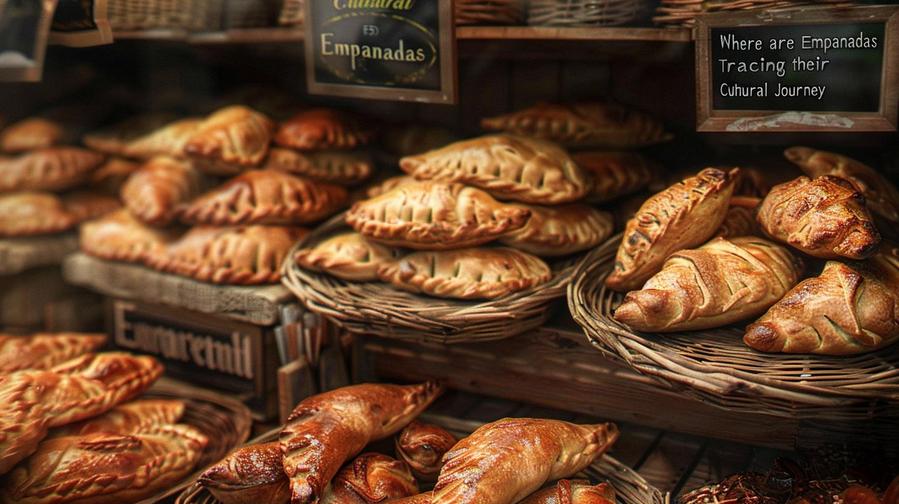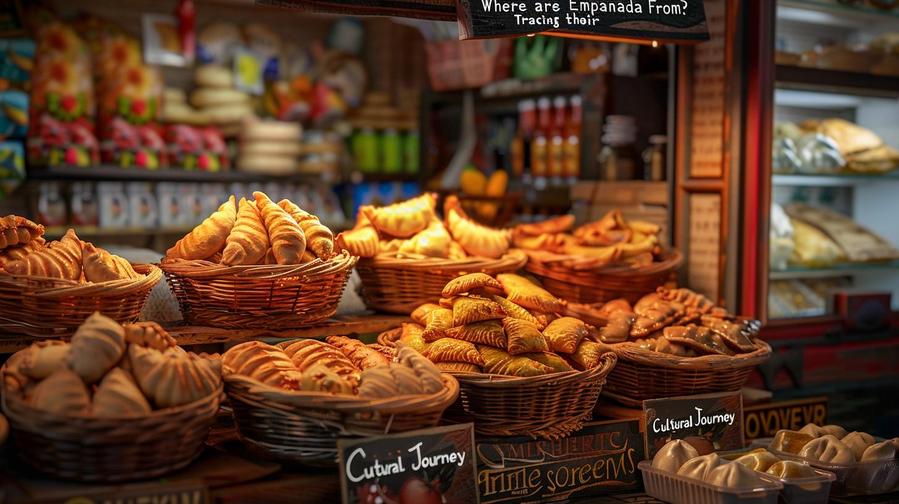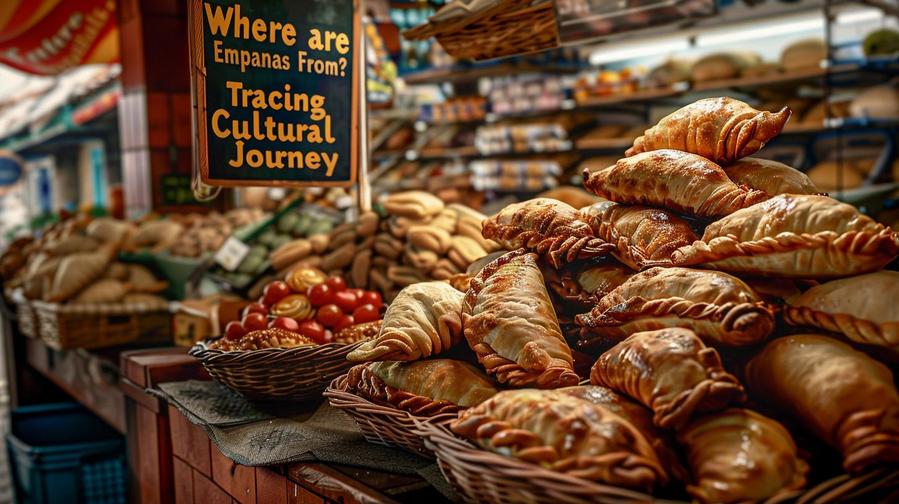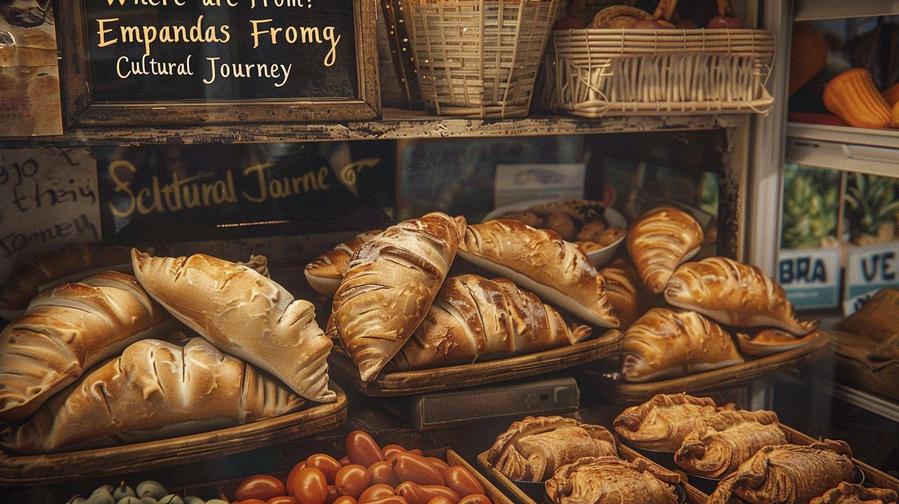Ever wondered where empanadas originated from? These delicious pockets of joy have a rich history that stretches across continents and cultures. Join us as we trace the cultural journey of empanadas, from their early origins to their role in Latin American cuisine and beyond. Prepare to embark on a tantalizing exploration of empanada history and discover how this humble dish has made its mark on the gastronomic world.
TL;DR: Empanadas originated in Spain and have evolved as they spread across regions. Initially, they were large double-crust pies with meat. Over time, they have become smaller, single-crust pockets filled with regional ingredients. Culturally significant in Spain and Latin America, empanadas symbolize unity and sharing. They also play a vital role in Latin American cuisine with diverse variations across regions. Cooking styles include baking and frying. As they've gone global, empanadas have adapted to local tastes, influencing modern gastronomy, and highlighting the dish's adaptability.

What is the Origin of Empanadas?
Empanadas hail from Spain. That's right, the savory pies we love so much began their journey in northern Spain. Brought to Argentina by immigrants, empanadas first appeared as larger pies with a double crust. Over time, they evolved into smaller, individual pockets of pastry, filled with various ingredients from each region.
Tracing the Roots of Empanadas
Let's delve a bit deeper into the history of the empanada. Originally, empanadas were made with dough and stuffed with meat. This basic form has remained consistent throughout centuries, but fillings and shapes have diversified, reflecting local tastes and resources. It's a testament to the versatility of the empanada, easily adapted to the flavors and ingredients of its new home.
The Journey of Empanadas from Spain to Latin America
When empanadas made their way from Spain to Latin America, they morphed once again. In Argentina, for instance, each province developed its own unique take on the empanada. From tripe-filled empanadas in Tucumán, rice-stuffed empanadas in Entre Rios, to goat or llama meat-filled empanadas in Jujuy, the variations are endless.
Cultural Significance of Empanadas in Spain
In Spain, empanadas hold significant cultural value. They're a common feature in local feasts and celebrations, symbolizing unity and sharing. Whether savored in a Spanish fiesta or an Argentine festival, each bite of an empanada is a taste of a rich and diverse cultural history. It's not just food, but an edible piece of our shared human story.
What is the Role of Empanadas in Latin American Cuisine?
Empanadas play a vital role in Latin American cuisine. In every corner of this diverse region, you'll find them, hot and crispy from the oven or the fryer, filled with a tantalizing array of ingredients.
Empanadas as a Staple in Latin America
The beauty of empanadas lies in their simplicity and versatility. At their core, they are hand-sized savory pies. Every province in Argentina, for example, has its own unique version, reflecting the local ingredients and tastes. They're not just a food; they're a cultural icon, a symbol of regional pride.
Variations of Empanadas across Latin America
The diversity of empanadas across Latin America is truly staggering. From the tripe-filled empanadas of Tucumán to the rice-stuffed ones of Entre Ríos, from the goat or llama meat-filled empanadas of Jujuy to the sweet-and-savory ones of Cordoba, each variant tells a story about the place it comes from.
The Influence of Empanadas on Latin American Food Culture
Perhaps the most telling sign of the importance of empanadas in Latin American food culture is the fierce competition between provinces in Argentina over who makes the best ones. Each claims superior fillings and dough, and locals are eager to guide visitors to their favorite spots. From the bustling streets of Buenos Aires to the quiet towns of the countryside, the love for empanadas is a constant, uniting factor.

How are Empanadas Made?
Creating an empanada isn't just about the filling, it's an art that starts with the dough. Making the perfect dough is the first step in creating an empanada that's worthy of praise.
Making the Perfect Empanada Dough
An easy homemade empanada dough is the backbone of any great empanada. The dough should be soft, yet not too sticky. It consists of flour, fat (usually lard or butter), water, and sometimes, a pinch of salt. For a healthier or dietary variant, a gluten-free empanada dough recipe can be used. This often involves using a blend of gluten-free flours and xanthan gum to mimic the texture of traditional dough.
Choosing the Right Empanada Fillings
The beauty of empanadas lies in their versatility. The filling can vary—from savory to sweet, and everything in between. In Argentina, empanadas are often filled with beef, onions, and peppers. However, variations abound, from tripe-filled empanadas in Tucumán to rice-stuffed empanadas in Entre Rios. In Misiones, you can even find gluten-free empanadas with a filling of mandioca.
Baked vs Fried: Two Methods of Cooking Empanadas
Empanadas can be either baked or fried. This depends on the region and personal preference. Baked empanadas are a bit healthier and have a flaky texture, while fried empanadas have a crispy, golden exterior. No matter how you cook them, rest assured, they're equally delicious.
From the perfect dough to the right filling and cooking method, making empanadas is an exciting culinary journey. It's a journey that takes us through the diverse flavors and traditions of Latin America. So, grab your apron, it's time to make some empanadas!
How Have Empanadas Evolved Globally?
Empanadas Beyond Latin America
We know empanadas as a Latin delight. But did you know they've spread far and wide? Yes, empanada variations around the world exist today. These tasty treats have found their way to every corner of the globe. Their journey is a testament to the global popularity of empanadas.
Adapting Empanadas to Local Tastes
As empanadas traveled, they changed. Each local culture put its spin on the recipe. The result? A wide array of empanada styles to enjoy. For example, Filipino empanadas often have a sweet, thin, flaky crust. They might be stuffed with chicken adobo or longganisa sausage. In the United States, you might find empanadas filled with Tex-Mex ingredients. In Portugal, they favor fish or chicken in their empanadas. This shows how adaptable and versatile the empanada truly is.
Empanadas in the Global Street Food Scene
Empanadas have also made a name for themselves as street food. From food trucks in Los Angeles to street stalls in Manila, they're everywhere. They're a favorite for their portability and ease of eating. No utensils needed, just your hands. Their pocket size also makes them perfect for a quick bite on the go. This has contributed to their popularity across the globe.
So next time you enjoy an empanada, remember its global journey. From Argentina to the Philippines, this little pie has traveled the world. It's adapted to new cultures, added new ingredients, and won over countless palates. And it's not done yet. Who knows where the empanada will go next?

What's the Difference in Empanadas Across Countries?
Empanadas, these savory hand pies, have made their mark in many countries. Yet, the taste and texture vary greatly from one place to another. From traditional Colombian empanadas to authentic Argentinian ones, and even to the Filipino versions, each has its own charm.
Comparing Empanadas: Colombia vs Argentina vs the Philippines
Let's start with Colombian empanadas. They are small, crispy, and often filled with meat, potatoes, and a hint of spice. On the other hand, Argentinian empanadas are larger, with a softer crust. They boast a variety of fillings, from beef and chicken to cheese and even sweet versions. Now, let's fly to the Philippines. Filipino empanadas are unique. They are sweet and savory, often filled with minced meat, raisins, and potatoes.
Famous Empanada Recipes from Different Countries
Each country has its own special empanada recipe. In Argentina, "Empanadas Tucumanas" filled with tripe are a must-try. In Colombia, you'll find "Empanadas de Pipián" filled with a mixture of potatoes and peanuts. And in the Philippines, the "Ilocos Empanada" with its bright orange crust and flavorful filling is a crowd favorite.
Unique Ingredients that Set Country-Specific Empanadas Apart
What sets these empanadas apart? It's all in the ingredients! Colombian empanadas are made with cornmeal dough, giving them a distinctive yellow color. Argentinian empanadas use wheat flour, making them lighter. They also often include olives and boiled eggs in their fillings. Filipino empanadas, on the other hand, use annatto oil, giving them a unique orange hue. The fillings often include local longganisa sausage and a whole boiled egg.
From Colombia to Argentina to the Philippines, each takes pride in their unique empanada recipe. So, the next time you bite into one, savor it. You're taking part in a culinary journey that spans continents and cultures.
What is the Cultural Significance of Empanadas?
Empanadas: More than Just a Dish
Empanadas are more than a meal. They are a cultural icon, a symbol of unity and identity among Latin Americans. These hand-sized savory pies, as the review points out, vary from region to region. Each province in Argentina, for example, boasts its own unique variety. The flavors captured within each pocket of pastry reflect the richness and diversity of Latin America's culinary heritage.
Empanadas in Traditional Celebrations
Empanadas also play a key role in traditional celebrations. They serve as a delicious testament to the strong sense of community that pervades Latin American culture. During festive gatherings, families and friends come together to prepare empanadas, turning the cooking process into a joyful communal event. This tradition of shared cooking and eating reinforces social bonds and fosters a sense of belonging.
Empanadas and Its Role in Upholding Cultural Identity
The humble empanada is more than a tasty snack. It's a part of the cultural identity of Latin America. Whether it's the tripe-filled empanadas of Tucumán, the rice-stuffed ones of Entre Rios, or the sweet and savory empanadas of Cordoba, each variant tells a unique story of regional culture and history. Argentines, for instance, take immense pride in their empanadas. These delectable treats are a source of regional pride and a marker of cultural identity, with each province claiming superiority over their fillings and dough. Thus, empanadas serve as a delicious lens through which to explore and appreciate the diverse cultural landscape of Latin America.

How Have Empanadas Influenced Modern Gastronomy?
The Impact of Empanadas on Contemporary Dining
Empanadas have made a mark in modern gastronomy. These savory pies have traveled far and wide from South America, earning a spot in menus around the world. Today, they add a unique flair to contemporary dining.
The Rise of Fusion Empanadas
Fusion cuisine has welcomed empanadas with open arms, leading to the rise of empanada fusion dishes. Chefs have been creative, mixing local flavors with the traditional empanada recipe. This has resulted in unique variations that excite the palate.
Empanadas in the Fast Food Industry
Furthermore, empanadas have found their way into the fast food industry. Many fast food chains have added their own spin on this Latin American classic. These portable, pocket-sized pies prove to be a perfect fit for the on-the-go lifestyle of the modern world.
In essence, the influence of empanadas in modern gastronomy is a testament to their universal appeal. Regardless of the changes and adaptations, the essence of the empanada remains – a simple, flavorful treat that brings people together.
How Has the Empanada Evolved Throughout History?
The Evolution of Empanadas Over Centuries
The story of the empanada takes us back to northern Spain. Then, they were larger, double-crusted pies. Over time, they evolved into the small, single-crusted pockets we know today. This change was influenced by the ingredients found in each region.
Empanadas in Historical Contexts
As empanadas traveled to South America, their form and fillings changed. They became a reflection of the local flavors. For instance, in Buenos Aires, you find empanadas in many shapes and fillings. Restaurants like La Cocina in Recoleta and Oro Verde in Palermo offer a wide variety.
The Symbolism Behind the Empanada
Empanadas are not just food; they hold cultural significance. Each province in Argentina claims their variant to be the best. The rivalries can be fierce! Some unique variants include the tripe-filled empanadas of Tucumán and the sweet-and-savory ones of Cordoba.
In the province of Misiones, you find gluten-free empanadas, made with mandioca flour. This shows how empanadas have adapted to cater to different dietary needs, reflecting their continuous evolution.
The journey of the empanada is a testament to its adaptability and enduring popularity. From being a large pie in Spain to becoming a hand-sized pocket of delight in South America, it's a dish that has traversed continents and cultures, each time transforming and adapting to the tastes of its new home.
We've traced the rich journey of empanadas, from Spanish roots to Latin American staple, and global favorite. We've explored the art of making them, their variations, and cultural significance. Empanadas have evolved, influencing modern gastronomy and embodying cultural identity. The humble empanada, a symbol of culinary history, continues to delight palates worldwide.



